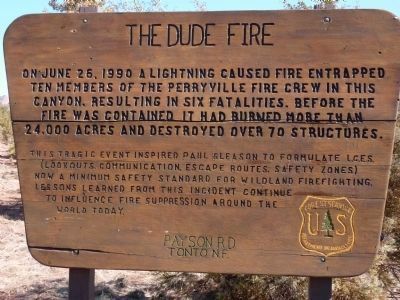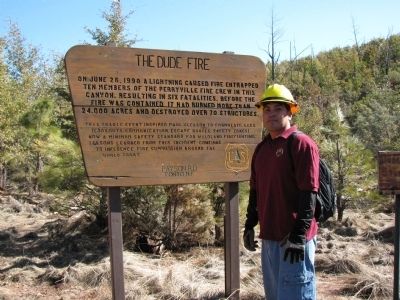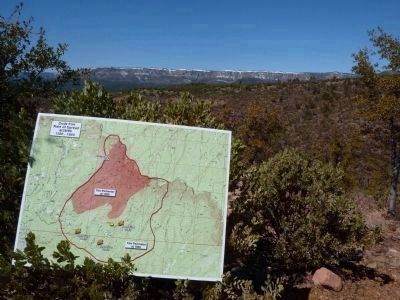Near Payson in Gila County, Arizona — The American Mountains (Southwest)
The Dude Fire
On June 25, 1990 a lightning caused fire entrapped ten members of the Perryville fire crew in this canyon. Resulting in six fatalities. Before the fire was contained it had burned more than 24,000 acres and destroyed over 70 structures.
This tragic event inspired Paul Gleason to formulate L.C.E.S. (Lookout, Communication, Escape Route, Safety Zones) now a minimum safety standard for wildland firefighting. Lessons learned from this incident continue to influence fire suppression around the world today.
Erected by United States Forest Service, Tonto National Forest, Payson Ranger District, Paid and Volunteer Staff Time.
Topics. This historical marker is listed in these topic lists: Disasters • Environment • Horticulture & Forestry. A significant historical month for this entry is June 1645.
Location. 34° 22.231′ N, 111° 14.165′ W. Marker is near Payson, Arizona, in Gila County. Marker is on Fire Control Road or "Control Road" (Route NF 64) 13.8 miles east of Arizona Route 260, on the left when traveling east. From Payson via SR 87, head north on SR 260 to Houston Mesa Road. Turn Right on Houston Mesa Road - go 10.2 mi. Turn Right on Control Road. Touch for map. Marker is in this post office area: Payson AZ 85541, United States of America. Touch for directions.
Other nearby markers. At least 8 other markers are within 12 miles of this marker, measured as the crow flies. These Trees Planted in Memory of the Firefighters Who Died in the Dude Fire June 26, 1990 (here, next to this marker); General Crook Trail (approx. 5.7 miles away); Battle of Big Dry Wash (approx. 5.8 miles away); Shoofly Village Ruin (approx. 6.2 miles away); C.C.C. Co. 807 (approx. 8.3 miles away); a different marker also named General Crook Trail (approx. 10.1 miles away); Site of the Herron Hotel (approx. 11.2 miles away); Ox Bow Inn (approx. 11.2 miles away). Touch for a list and map of all markers in Payson.
More about this marker. There is a small parking lot on the North side of the road. The sign marks the head of Walk Moore Canyon, site of the Dude Fire entrapment in 1990.
Regarding The Dude Fire. The Dude Fire fatality site is part of a "Staff Ride" used to train Wildland Fire professionals in safety and decision making. The ride puts participants in the shoes and minds of a local unit administrator (i.e. USFS Ranger District) and people fighting fire on the ground. The Staff Ride tries to re-create the situation on the day of the event, and stimulate thought, discussion, and a final distillation of the Lessons Learned. In 1990, the Dude Fire investigation and review helped create reform in firefighter work practices
(shift length), physical fitness requirements, fire communications, extreme fire behavior training, fire shelter location on line packs, creation of the Lessons Learned Center, and refinement of drought, weather and other extreme fire prediction techniques. This event crystallized Paul Gleason's formulation of L.C.E.S to distill the 10 Standard Firefighting Orders and 18 Watchout Situations into four easy to remember safety points: Lookouts, Communication, Escape Routes, Safety Zones. Superintendent of Oregon's Zig-Zag Hotshot crew, Gleason was the first person on scene at the main entrapment site.
Also see . . .
1. Wildland Fire Leadership Council Dude Fire Staff Ride Page. In its quest to improve safety and leadership response, the Wildland Fire Community turned to military officer leadership training. The Staff Ride technique is borrowed from military battle review practices. (Submitted on March 7, 2010.)
2. Historic and Contemporary Images from the Dude Fire and Staff Ride. (Submitted on March 7, 2010, by Chris English of Phoenix, Arizona.)
3. Wildland Fire Magazine Fall 2002 Issue Devoted to the Dude Fire Staff Ride. Researching the history of the Dude Fire and Staff Ride concept, the Dude Fire was apparently the first instance of the military staff ride concept brought into the wildland fire professional community. (Submitted on March 7, 2010.)
4. The Dude Fire. Northern Gila County Historical Society website entry:
2010 page is devoted to the 20th anniversary
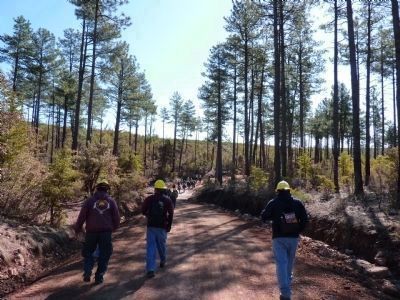
March 5, 2010
3. Attendees of a Dude Fire Staff Ride Walk Through Forest Remnants
The effects of the Dude Fire are visible twenty years after the fire. A few remnant pines are shown here. The intention on the second day of the fire was to protect housing east of Walk Moore Canyon, stop the main head of the fire, and keep fire size to a minimum.
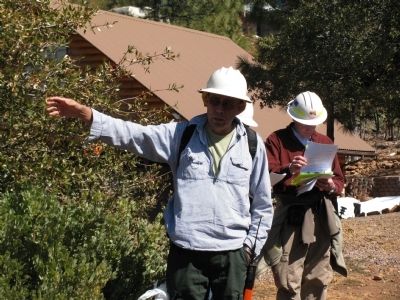
Photographed By Leon Ben Jr., March 5, 2010
4. Building the June 26, 1990 Scenario
Jonathan Lee, Foreman of the Plumas Hotshots on June 26, 1990 discusses the conditions and events leading to the Dude Fire Entrapment immediately south of the Safety Zone near the Corner House. More than 130 people evacuated to the safety zone about 2 P.M. on June 26, 1990.
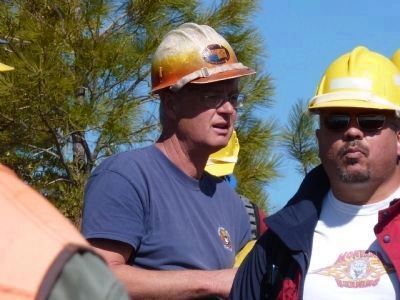
March 5, 2010
5. Max Wahlberg Presents His Experience on the Dude Fire
Wahlberg played several roles on the Dude Fire and is one of the Wildland Fire professionals maintaining the staff ride and often donating time to maintain trails, and prepare documents, maps and photos. Darryl Martinez, Bureau of Indian Affairs Southwest Region Burned Area Emergency Rehabilitation expert and Coordinator gets serious with the photographer.
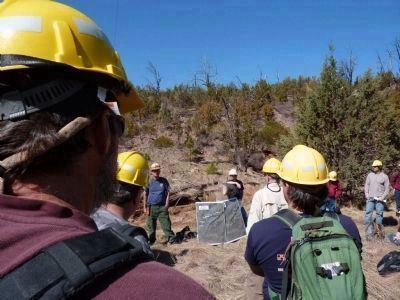
March 5, 2010
6. Stop Near the Walk Moore Canyon Power Line
Early morning events of June 26 are set up. The Perryville crew had already worked, traveled and staged 30 hours and were put into the canyon at 2:30 AM. Twelve hours later the fire developed into what used to be a rare "plume dominated" fire, pushing over 60,000 feet into the sky, then collapsing as the heat column cooled in the upper air.
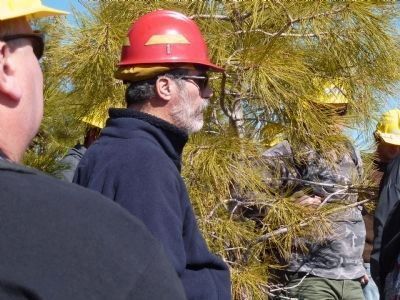
March 5, 2010
7. J.P. Mattingly, Superintendant of the Alpine Hot Shots June 26, 1990
Mattingly, Crew Superintendent, was on scene June 26 during every turn of events. He and other crew Superintendents were instrumental in saving the lives of their crews, local fire department employees and members of the press.
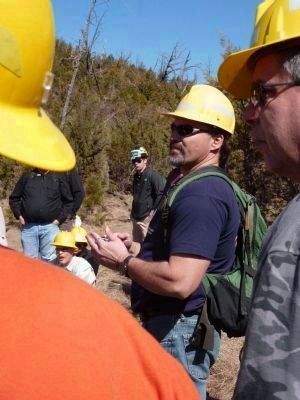
March 5, 2010
9. Bodie Shaw, Former Member of the Flathead Interagency Hot Shot Crew
On June 26, 1990, Shaw's crew and six others were saved by crew Superintendent intuition and awareness, and a very large safety zone, a large burned over area with a center zone cleared by a bulldozer immediately before the blow-up. The Perryville Crew responded late to a member of Navajo Scout Crew 2 who shouted at them to leave Walk Moore Canyon. Their fire shelters were buried under equipment in their packs. Some members of the crew died helping others get into shelters. Other crew memberss deployed fire shelters improperly, and others paniced, ran, and were overcome by heat and gases.
Shaw is now Deputy Director, Bureau of Indian Affairs programs, National Interagency Fire Center. Right foreground, in camo, is Lyle Carlile, Director BIA NIFC programs.
Credits. This page was last revised on March 5, 2023. It was originally submitted on March 6, 2010. This page has been viewed 5,052 times since then and 59 times this year. Photos: 1. submitted on March 6, 2010. 2. submitted on March 8, 2010. 3, 4, 5, 6, 7, 8, 9. submitted on March 6, 2010. • Syd Whittle was the editor who published this page.
